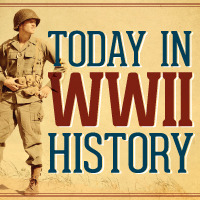Sarah Sundin's Blog, page 417
August 24, 2013
Today in World War II History
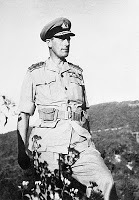 Admiral Lord Louis Mountbatten
Admiral Lord Louis Mountbatten Arakan Front, Burma,
February 1944
(Imperial War Museum)70 Years Ago—Aug. 24, 1943: Danish Resistance blows up Forum Hall in Copenhagen. Southeast Asia Command authorized with Adm. Lord Louis Mountbatten as Supreme Allied Commander.
Published on August 24, 2013 01:00
August 23, 2013
Today in World War II History
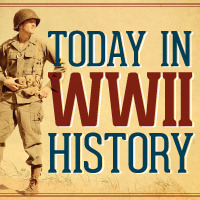 70 Years Ago—Aug. 23, 1943: Soviets take Kharkov, the fourth and final time it changes hands; Germans lose Donets Basin industrial area. Japanese aircraft bomb Chungking, China for first time since 1941, also the last major attack on Chungking.
70 Years Ago—Aug. 23, 1943: Soviets take Kharkov, the fourth and final time it changes hands; Germans lose Donets Basin industrial area. Japanese aircraft bomb Chungking, China for first time since 1941, also the last major attack on Chungking.
Published on August 23, 2013 01:00
August 22, 2013
Book Beat - Welcome to Last Chance by Cathleen Armstrong
 When Lainie Davis's car dies, the little town of Last Chance, New Mexico is truly her last chance. She has an angry ex-boyfriend on her tail - and no money to fix her car. Lainie takes a waitressing job at the Dip 'n' Dine, but as a tough, wounded city girl, she rubs a lot of people the wrong way - and yet brings out the protectiveness in others.
When Lainie Davis's car dies, the little town of Last Chance, New Mexico is truly her last chance. She has an angry ex-boyfriend on her tail - and no money to fix her car. Lainie takes a waitressing job at the Dip 'n' Dine, but as a tough, wounded city girl, she rubs a lot of people the wrong way - and yet brings out the protectiveness in others.Meanwhile Ray is running his late father's bar - but only until his brother Steven can take over. He can't wait to leave this town and pursue his art.
I love a good small-town story, but they often veer into cheesiness. Not Welcome to Last Chance . Cathleen Armstrong has seasoned her town with a healthy dose of hot chili! The town and its people become a character all their own.
Welcome to Last Chance gives us a warm but never sentimental view of small town life, sprinkled with characters full of quirks and faults—all seen through the eyes of a tough but fragile heroine. Cathleen Armstrong has crafted a story to cherish. A wonderful debut novel. I can't wait for the second book in the "A Place to Call Home" series.
Published on August 22, 2013 02:00
Today in World War II History
 70 Years Ago—Aug. 22, 1943: German Tenth Army activated in southern Italy under Gen. Heinrich von Vietinghoff. In the Mediterranean, all fighter groups and medium bomb groups in US Ninth Air Force transferred to Twelfth Air Force (Ninth AF to transfer to England).
70 Years Ago—Aug. 22, 1943: German Tenth Army activated in southern Italy under Gen. Heinrich von Vietinghoff. In the Mediterranean, all fighter groups and medium bomb groups in US Ninth Air Force transferred to Twelfth Air Force (Ninth AF to transfer to England).
Published on August 22, 2013 01:00
August 21, 2013
Today in World War II History
Published on August 21, 2013 01:00
August 20, 2013
Today in World War II History
Published on August 20, 2013 01:00
August 19, 2013
Hospitalization in World War II - Mobile and Fixed Hospitals
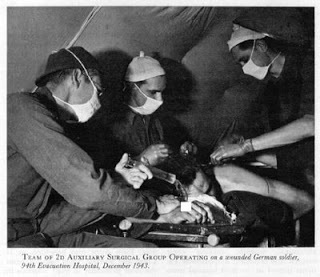 Surgeons at 94th Evacuation Hosptial, Italy, December 1943
Surgeons at 94th Evacuation Hosptial, Italy, December 1943(US Army Medical Dept.)Hutch crossed his arms over his soggy mackinaw and gave Bergie half a smile. "You said you'd take over. Ever pitch a tent before?"
"In Boy Scouts." The surgeon raised a three-finger salute. "On my honor--"
"A big old Army ward tent?"
"Nope. But I'm willing to get dirty. What's mud compared to the blood and guts I usually swim in?"
Hutch turned to Sergeant Paskun. "I'll put the captain on my team and mess up his pretty officer's manicure."
"Heavens to Betsy!" Bergie said in a falsetto, inspecting his fingernails. "I just had them done." (On Distant Shores, p. 150)
In my new novel On Distant Shores , the hero serves as a pharmacist in an evacuation hospital and the heroine serves as a flight nurse. To celebrate the book’s release, I’m running a series on hospitalization in World War II. Earlier I discussed the chain of evacuation, today I’ll discuss mobile and fixed hospitals in more detail, and then I’ll cover evacuation of the wounded.
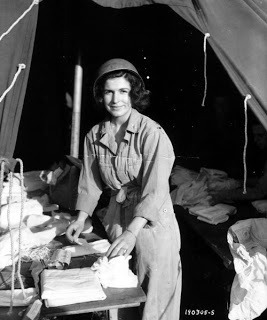 US Army nurse preparing dressings, June 15, 1944
US Army nurse preparing dressings, June 15, 194413th Field Hospital, Saint Laurent sur Mer, Normandy
(US National Archives) Mobile Hospitals
Field hospitals (400 beds) and evacuation hospitals (400 or 750 beds) arrived within a few days of an invasion and followed the army, staying about thirty miles behind the front. They were close enough to treat patients quickly and send them back to the front quickly as well.
These hospitals relied on mobility. They usually used canvas tents, but also used schools, barracks, hospital buildings, hotels, Mediterranean villas, and an Italian stadium. A few days before a move, the hospital stopped admitting patients and evacuated their current patients to other hospitals. They packed their equipment and personnel into trucks, advanced, set up, and were ready to admit patients within hours.
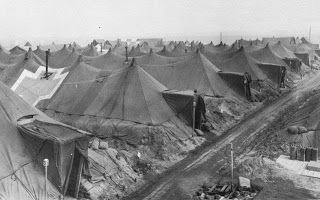 Revetted hospital tents on the Anzio beachhead, Italy, spring 1944
Revetted hospital tents on the Anzio beachhead, Italy, spring 1944(US Army Medical Dept.)When ambulances arrived, triage officers sent patients to pre-op, medical, shock, or evacuation wards as needed. Surgical teams worked twelve hours on, then twelve hours off.
In the European Theater (England, France, Belgium, Germany), the field hospitals stayed closer to the front, with the evacuation hospitals further to the rear. In the Mediterranean Theater (North Africa, Sicily, Italy, southern France), field hospitals and evacuation hospitals were used interchangeably. Both theaters practiced “leapfrogging” as the front advanced—hospital A would pass hospital B, then hospital B would pass hospital A. This reduced the frequency of moves.
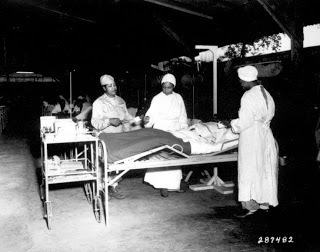 African-American US Army nurses Lt Prudence Burns, Lt Elcena Townscent
African-American US Army nurses Lt Prudence Burns, Lt Elcena Townscentand a 3rd nurse treating Sgt Lawrence McKreever
268th Station Hospital, Milne Bay, New Guinea, 22 Jun 1944
(US National Archives) Fixed Hospitals
The station hospitals (250, 500, or 750 beds), general hospitals (1000 beds), and convalescent hospitals (2000 or 3000 beds) were set up far from the front to keep patients safe from danger, but also to keep them in the theater, which made it easier to return the soldiers to duty. In England before D-Day, field and evacuation hospitals waiting for the Normandy invasion functioned as station hospitals to care for patients.
In each theater of operations, fixed hospitals operated in what was called the “Communications Zone.” In the European Theater, the COMZ was originally in England, then as the Allies approached the German border, the COMZ extended to include Normandy and Belgium. In the Mediterranean Theater, Morocco served as the first COMZ, then Algeria. When the Allies invaded Sicily and Italy, North Africa was the COMZ, and as the front advanced, the COMZ was established in the Naples area of southern Italy. In the Pacific, fixed hospitals were first established in Hawaii and Australia, then followed into secured regions.
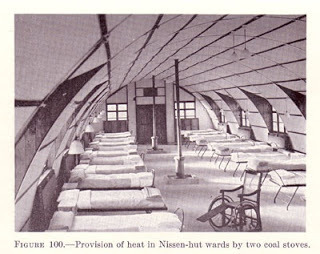 Nissen-hut hospital in England. Note coal stoves in centerFixed hospitals moved less often and occupied more permanent facilities. American units used some standing hospitals in host or occupied countries, but many were a collection of tents or Nissen huts, 20-ft by 40-ft corrugated tin semi-cylinders. In England, Nissen-hut hospital complexes were often placed on estate grounds, and had concrete floors, flush toilets, clean water, and were heated by coal-burning stoves. In the Mediterranean and Pacific, facilities were more primitive but improved over time. In these theaters, mosquito netting was draped over the beds to prevent transmission of malaria.
Nissen-hut hospital in England. Note coal stoves in centerFixed hospitals moved less often and occupied more permanent facilities. American units used some standing hospitals in host or occupied countries, but many were a collection of tents or Nissen huts, 20-ft by 40-ft corrugated tin semi-cylinders. In England, Nissen-hut hospital complexes were often placed on estate grounds, and had concrete floors, flush toilets, clean water, and were heated by coal-burning stoves. In the Mediterranean and Pacific, facilities were more primitive but improved over time. In these theaters, mosquito netting was draped over the beds to prevent transmission of malaria.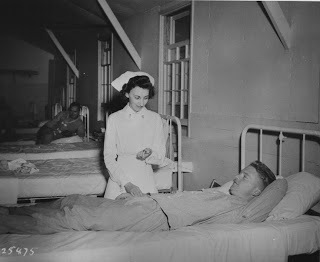 Army nurse attending patient, Camp Forrest TN, 22 Sept. 1941
Army nurse attending patient, Camp Forrest TN, 22 Sept. 1941(US Army Medical Dept.)Fixed hospitals in the Zone of the Interior (continental United States) enjoyed the benefits of modern buildings and facilities. However, shortages of medication, equipment, and personnel were always a problem.
Published on August 19, 2013 02:00
Today in World War II History
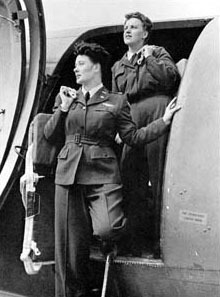 WASP C-47 flight crew: Pilot Joanna Trebtoske (Jenks), left,
WASP C-47 flight crew: Pilot Joanna Trebtoske (Jenks), left,and Copilot Marjorie Logan (Rolle)
at Romulus Army Air Field, Mich. (U.S. Air Force photo)70 Years Ago—Aug. 19, 1943: Australians take Mt. Tambu and Komiatum Ridge, New Guineaafter month of fighting. First Wasps (woman pilots) assigned to US Troop Carrier Command. Movie premiere of Du Barry Was a Lady—Cole Porter musical with Red Skelton, Lucille Ball, Virginia O’Brien.
Published on August 19, 2013 01:00
August 18, 2013
Today in World War II History
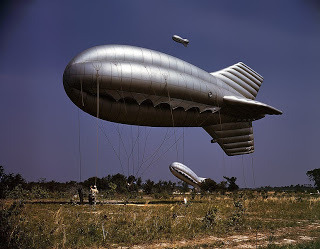 Barrage balloon, Parris Island, South Carolina, May 1942
Barrage balloon, Parris Island, South Carolina, May 1942(US Library of Congress)70 Years Ago—Aug. 18, 1943: Luftwaffe chief of staff, Hans Jeschonnek, commits suicide after previous day’s RAF raid on Peenemünde and US 8th AF raids on Schweinfurt and Regensburg. Army Air Force barrage balloon battalions inactivated in US.
Published on August 18, 2013 01:00
August 17, 2013
Today in World War II History
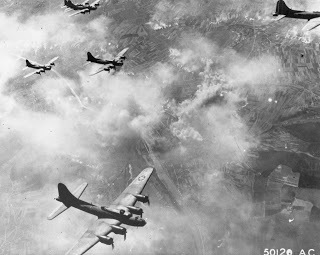 B-17s over Schweinfurt, Germany, 17 August 1943 (USAF)70 Years Ago—Aug. 17, 1943: US Eighth Air Force sends 376 bombers to Schweinfurt and Regensburg, 60 bombers lost. US takes Messina and Allies secure Sicily, taking 160,000 POWs. RAF sends 597 bombers to Peenemünde, Germany, bombing rocket installations for first time.
B-17s over Schweinfurt, Germany, 17 August 1943 (USAF)70 Years Ago—Aug. 17, 1943: US Eighth Air Force sends 376 bombers to Schweinfurt and Regensburg, 60 bombers lost. US takes Messina and Allies secure Sicily, taking 160,000 POWs. RAF sends 597 bombers to Peenemünde, Germany, bombing rocket installations for first time.
Published on August 17, 2013 01:00

